Part 4
Americanization and Japanization
The San Francisco Peace Treaty signed in 1951 left Okinawa under American control. Okinawa took on huge importance as the keystone for America’s military strategy in the Far East, serving as bulkwark against the rising power of Red China’s combined nationalism and socialism. Meanwhile, Japan used Okinawa as a pawn for bolstering the “national body,” centered on an Imperial ideology shaken by wartime defeat. However, Okinawa itself was not subject to any particular “ism,” and Okinawans went on living their everyday lives. But to free themselves of the absurdity of U.S. control, Okinawans came to see Japan as their “mother country” and became especially conscious of the process of Japanization. There was a strange resonance between Japan and America in Okinawa. The films in this section revisit the ways in which America and Japan used Okinawa as a stage for their own promotion, and reconsider the historical changes in Okinawan dreams and resistances that were shaken in the gulf between these two states.
| 1 | Promotion in the American Era |
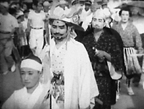 Raising Ryukyu
Raising Ryukyu
(“Tachiagaru Ryukyu”)- B&W / Video (orig. 35mm) / 37 min
Production: CI&E, USCAR (United States Civil Administration of the Ryukyu Islands), GRI (Government of the Ryukyu Islands)
Source: Okinawa Prefectural Archives
A promotional film about Okinawa by the United States Information Service. The reality of 1950s Okinawa forms the background of this film—the increased importance of Okinawa in Asia due to the Korean War, and the compulsory land requisition for the construction of military bases. This story reflects the focus of occupation strategy, turning a blind eye to the fact that the majority of Okinawa’s fertile land was taken over and covered in iron and concrete and proposing immigration as the solution to poverty and overpopulation.
 These Ten Years, Part 1
These Ten Years, Part 1
(“Kono ju nen: Dai 1 bu”)- circa 1955 / B&W / Video (orig. 35mm) / 14 min
Production: CI&E, USCAR
Source: Ryukyu Broadcasting Corporation (RBC)
This propaganda film glorifies America’s role in the ten-year revival of Okinawa following the devastation of the Battle of Okinawa. Okinawa endured the man-made disaster of war and natural disasters including typhoons and droughts. But thanks to the construction of irrigation facilities, roads, modern buildings, filtration plants, power plants and other infrastructure projects, in ten years Okinawa reached a level of prosperity unknown in Ryukyu history. But the punch line is that the American people had to foot the bill.
 A Selection from Ryukyu News
A Selection from Ryukyu News
- B&W / Video (orig. 35mm) / 65 min
Production: CI&E, USCAR
Source: RBC
Upon the reversion of Okinawa to Japan, many of the films made by the United States Civil Administration of the Ryukyu Islands (USCAR) were transferred to the U.S. National Archives and Records Administration. However, some publicity and news films were kept at places like the Ryukyuan-American Friendship Center, a medium for “Ryukyu-U.S. friendship” promoted as part of America’s pacification policy. Screened here are Ryukyu News 1, 6, 9, 12, and 16 and the short New Weapon Hawk Missile, first-class visual materials on the American occupation of Okinawa.
| 2 | Soul-graphy of the A-Sign Era |
 Okinawan Boys
Okinawan Boys
(“Okinawa no shonen”)- 1983 / Japanese, English / Color / 35mm / 117 min / English subtitled version
Director: Shinjo Taku
Script: Nakada Shinichiro, Takagiwa Kazuo, Shinjo Taku
Based on the novel by: Higashi Mineo
Photography: Himeda Shinsaku
Sound: Yoneyama Hideaki
Music: Ikebe Shinichiro
Art Director: Saito Yoshio
Producer: Suzuki Wataru
Cast: Fujikawa Ippo, Naito Takashi, Ono Miyuki, Okada Nana, Kawarasaki Choichiro
Production Company: PAL Entertainments Production
Source: Kawakita Memorial Film Institute
Okinawan-born Shinjo Taku made his directorial debut with Okinawan Boys, a film based on the same-titled work from author Higashi Mineo, also from Okinawa. The film depicts the struggles of Okinawan youth prior to the region’s reversion to Japanese sovereignty, intermingling protagonist Higa Tsuneo’s tenuous existence in Tokyo within both dreams and reality, and childhood days spent in Okinawa amongst the turbulence of G.I. and women. Portrays a turbulent era in both Okinawa and Japan, starting with the town of Kin, Okinawa in 1959 and encompassing the Ampo (Security Treaty) struggles of both 1960 and 1970.
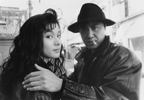 Via Okinawa
Via Okinawa
(“Ei sain deizu”)- 1989 / Japanese, English / Color / 16mm (orig. 35mm) 111 min / English subtitled version
Director: Sai Yoichi
Script: Saito Hiroshi, Sai Yoichi
Based on the story by: Tonegawa Yutaka
Photography: Hamada Takeshi
Editing: Tomita Isao
Music: Ishikawa Ko
Art Director: Imamura Tsutomu
Executive Producers: Yamamoto Yo, Sato Masahiro
Producer: Tsuchikawa Ben
Cast: Nakagawa Anna, Ishibashi Ryo, Hirota Reona, SHY, Urata Kenichi, Shimizu Akihiro
Production Company: Daiei
Source: The Japan Foundation
The “A” in the Japanese title of this film, ‘A’ Sign Days, refers to signs posted in shops “approved” to offer entertainment and amusement services to U.S. military personnel. Taking place in Okinawa during the Vietnam War, this work portrays young rock band members, based on real-life rock singer Kyan Mary. The film begins with U.S.-occupied Okinawa in 1968 and closes with the end of the Vietnam War in 1975.
| 3 | Longing for the Mother Country / Across the 27th Parallel |
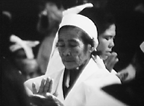 Okinawa: Road to the Homeland
Okinawa: Road to the Homeland
(“Okinawa: Sokoku e no michi”)- 1967 / Color / 16mm (orig. 35mm) / 22 min
Director, Script: Kurosawa Tsuyoshi
Photography: Ota Tatsuo, Akatsu Mitsuo
Editing: Nakano Kiyosaku
Sound: Kurosu Akira
Narrator: Yoshioka Shinya
Producer: Tsushima Yoshitake
Planning: Assistance Association for Okinawa and Ogasawara
Production Company, Source: Mainichi Productions
A publicity film based on the slogan “embrace Okinawa and Ogasawara back to the motherland,” used by the Assistance Association for Okinawa and Ogasawara. This group lobbied for the return of Okinawa and the Ogasawara Islands to Japan, and later expanded their sphere of interest to include the northern territories. In its view, “Okinawa as part of Japan cut off at the twenty-seventh degree line” was “territory lost during the Pacific War.” The territory’s return to Japan is described in terms of a mother and child embracing and is symbolized by strong yearning for the rising-sun flag.
 The Voice of Okinawa
The Voice of Okinawa
(“Okinawa no koe”)- 1969 / Color / 16mm (orig. 35mm) / 30 min
Planning: Japan Information Center, Assistance Association for Okinawa and Ogasawara
Production Company, Source: Mainichi Productions
This work is a companion piece to Okinawa: Road to the Homeland. The Voice of Okinawa was produced in 1968, just as the U.S. and Japan were concluding negotiations on returning Okinawa to Japanese authority—and therefore projects an even stronger message about the issue of restoration. The Voice of Okinawa explores the contradictions surrounding the domination of an ethnic “other,” seen in the stationing of B-52 bombers, the hordes of vehicles that were returned from Vietnam riddled with fresh bullet holes, and the training of Special Forces destined for jungle battle. This film is clearly driven by the theme of race.
 Cries Coral Reef
Cries Coral Reef
(“Ishi no uta”)- 1965 / B&W / 16mm / 41 min
Director: Numasawa Isezo
Photography: Osawa Hiroshi, Akashiro Manabu
Sound: Okazaki Michio
Planning: Nara Saburo
Producers: Nonomura Akira, Kitamura Sonsei
Production Company: Okinawa Eiga Productions
Source: The Japan Teacher’s Union
Japan and Okinawa are symbolized by the tragic love tale told in Yaeyama of a man and woman separated, but Okinawa plays the woman who is forced to grieve for the man she is separated from. The film provides an interesting comparison with Okinawa: Road to the Homeland, which is modeled on the relationship between mother and child. This film shows the connection between movements in Japan and Okinawa that campaigned for an end to the U.S. occupation of Okinawa.
 Eighteen in Okinawa
Eighteen in Okinawa
(“Okinawa no 18 sai”)- 1966 / B&W / Video / 25 min
Directors: Toyotomi Yasushi, Moriguchi Katsu
Photography: Moriguchi Katsu
Editing: Sugiyama Tadao
Narrator: Suzuki Mizuho
Producer: Ushiyama Junichi
Production Company, Source: Nippon Television Network Corporation (NTV)
Broadcast Date: July 21, 1966
This piece is first in the Eighteen in Okinawa series by Moriguchi Katsu. It first aired in 1966, when Okinawa was still under U.S. military control. The main character Uchima Yasuo is a third-year public high school student, born and raised in a poor household near the Kadena U.S. Air Base. Uchima and his classmates participate in a memorial processional by families remembering loved ones killed in the war. His classmates’ opinions on the reversion of Okinawa to Japan are divided, with some favoring return to Japan, others in opposition, and still others thinking it is too soon, symbolizing the agony of Okinawans opposing U.S. control while necessarily relying on the bases.
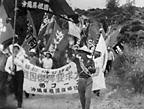 History of the Reversion Struggle
History of the Reversion Struggle
(“Fukkikyo toso shi”)- 1977 / Color, B&W / Video (orig. 16mm) / 40 min
Planning: Okinawa Prefecture Reversion Council
Production Company, Source: RBC
The Okinawa Prefecture Reversion Council was formed on April 28, 1960 and played a central role in the people’s movement to return Okinawa to Japan until it was dissolved on May 15, 1977. These images were put together when the Council was dissolved, and form a kind of official history of the reversion movement’s activities. This valuable visual record covers many aspects of Okinawa's turbulent post-war history.
| 4 | The Return of Okinawa: Behind the Scenes |
As Okinawa Goes, So Goes Japan: Secret Documents Shed Light on the Return of Okinawa
(“—Himitsu bunsho ga akasu Okinawa henkan”)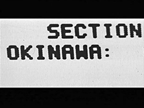 1997 / Color / Video / 45 min
1997 / Color / Video / 45 min
Directors: Tsuchie Makiko, Kikuzato Itsuko
Photography: Kasama Hiroyuki, Higa Hidehiko, Funakoshi Yoshito
Online Editing: Ishado Tomoki
Narrators: Watanabe Noritsugu, Nema Tatsuya
Producer: Ahagon Asanobu
Production Company, Source: Ryukyu Asahi Broadcasting Corporation (QAB)
“As Okinawa Goes, So Goes Japan” was a phrase often used by U.S. government officials involved in negotiations for the reversion of Okinawa. The U.S. was in full control over the reversion of Okinawa and pushed negotiations in its favor. What was the U.S. government demanding? Based on an internally circulated classified “case study,” this TV documentary interviews Japanese and U.S. government officials from that time to investigate the U.S. negotiation strategy hidden within Okinawa's reversion.
Whistle-blowing: Thirty Years Since the Leak of Secrets from the Ministry of Foreign Affairs—The Truth That Can at Last Be Told
(“Kokuhatsu: Gaimusho kimitsu roei jiken kara 30 nen, Ima katarareru shinjitsu”)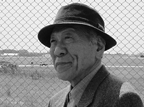 2002 / Color / Video / 45 min
2002 / Color / Video / 45 min
Director: Tsuchie Makiko
Photography: Kasama Hiroyuki, Fukuhara Tetsuya, Michel Ford
Editing: Fukuhara Tetsuya
Narrative Structure: Nozawa Kazuyuki
General Producer: Nakazato Masayuki
Producer: Ikehara Akane
Production Company, Source: QAB
There was a secret treaty behind the Okinawa reversion that wasn't allowed to be discussed. The four million dollars compensation the U.S. government paid to residents of Okinawa was in fact shouldered by the Japanese government. This secret agreement was exposed by the newspaper journalist Nishiyama Takichi. But because Nishiyama obtained the classified telegram from a female Ministry of Foreign Affairs official, the news about the secret treaty turned into a scandal about the liaison between Nishiyama and the woman. In this TV documentary Nishiyama appears in front of the television camera for the first time and breaks the thirty-year silence about the incident while sharing his keen observations about Okinawa.
News Film “Those Times” (from Yomiuri International News)
No. 1044 Turbulent Okinawa
No. 1168 Signing of the Okinawa Reversion Agreement
No. 1215 Okinawa Returns Home
 1968-72 / B&W / 16mm, Video (orig. 35mm) / 15 min
1968-72 / B&W / 16mm, Video (orig. 35mm) / 15 min
Source: Yomiuri Eizou Co.,Ltd
This program aims to collect evidence about the conditions during the period surrounding the reversion of Okinawa to mainland Japan from 1968 to 1972. Three themes were selected from Yomiuri International News: “The strengthened consciousness against American rule in Okinawa,” “The conditions in Okinawa and Japan at the time of signing the Okinawa Reversion Treaty,” and “The post-reversion situation.”
| 5 | In the Gulf between America and Japan |
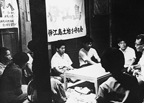 Okinawa Islands
Okinawa Islands
(“Okinawa retto”)- 1969 / B&W / 16mm (orig. 35mm) / 90 min
Director, Script, Editing: Higashi Yoichi
Assistant Director: Maeda Katsuhiro
Photography: Ikeda Denichi
Sound: Kubota Yukio, Honma Kimio
Music: Matumura Teizo
Producer: Takagi Ryutaro
Production Company: Higashi Productions
Source: Siglo
The first full-length film directed by Higashi Yoichi. From August to October 1968, a film crew from the Japanese mainland ventured into U.S.-controlled Okinawa. Student struggles entered a new phase from 1968, rejecting “values” in the broad sense of the word. Higashi strongly felt the need to be free from previously established values, choosing in this work to grapple with the theme of Okinawa. The Okinawan problems analyzed in this film remain unresolved today.
Breaking through Hard Ground—Okinawa ’71—
(“Kataki tsuchi o yaburite: Okinawa ’71”)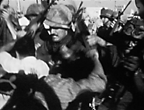 1971 / Color / Video / 25 min
1971 / Color / Video / 25 min
Directors: Maeda Masaru, Moriguchi Katsu
Photography: Moriguchi Katsu, Taguchi Ko, Matsumoto Hiroshi
Editing: Aoki Hideaki
Narrator: Terada Minori
Producer: Mori Yasuo
Production Company, Source: NTV
Broadcast Date: January 3, 1971
On December 20, 1970, an Okinawan man was struck by the car of a U.S. soldier who was driving while drunk. The management of that accident caused the so-called “Koza Riot.” This work investigates why the Okinawan peoples’ anger found voice in this incident, through looking at such issues as the violations and accidents committed by U.S. military personnel, and accusations pointed out by intellectuals regarding Okinawa’s contradictory role as “Far East arsenal” and “keystone of the Pacific.”
Forty Years of the Post-war Series: The Footsteps of Young Okinawans
(“Shirizu ‘sengo 40 nen’ wakaki Okinawa tachi no kiseki”)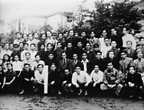 1985 / Color / Video / 50 min
1985 / Color / Video / 50 min
Director: Moriguchi Katsu
Photography: Matsumoto Hiroshi, Gokeniwa Shunichi, Suzuki Akira
Editing: Kuroda Michinori
Sound: Uchida Hiroshi
Narrator: Tsukayama Masane
Producer: Kikuchi Hirosuke
Production Company, Source: NTV
Broadcast Date: April 14, 1985
In November 1983 a light went out in Komae City, Tokyo. The Southern Light Dormitory, a student dormitory for Okinawans in Tokyo, too old to use, was torn down. At the time this work was made 2,000 students had stayed at the dormitory. Most returned to their homeland Okinawa after graduating from university, and were active in Okinawa in various ways. This TV documentary includes interviews with former residents about their thoughts on Okinawa, their involvement and the paths they chose, mixed with footage from Okinawa’s turbulent years.
